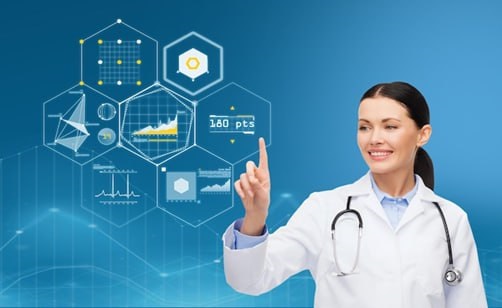Applications of Natural Language Processing in Healthcare Industry
Artificial Intelligence is contributing to the various aspects of the healthcare industry. The domain is subject to extensive research for the sole purpose of overall development of the healthcare industry that would be more potent to fight against physical and mental challenges facing the population. Natural Language Processing (NLP) is one such technique of deep learning that shells out various capabilities of AI in fields of data management, clinical trials, and calculated medical decision-making. Ample models have been developed that demonstrate positive results in terms of data management and physical and mental well-being.
Applications of NLP in Healthcare Industry
Deidentification of Clinical Records
Natural language processing techniques are contributing to the advancement of Electronic Health Records (EHR) management in the healthcare industry. The NLP techniques that use recurrent neural network models are applied to process unstructured electronic health record notes to extract clinical information such as signs and systems that are represented by named entities. Further NLP systems are also used for the extraction of information from electronic medical records with clinical free text with a motive to integrate best-of-breed annotators. Also, the use of rule-based learning can contribute effectively to the deidentification of clinical records and can serve as a typical application in medical informatics. Assistive diagnostic systems have been designed that simultaneously diagnose the disease and produce a list of corresponding syndromes.
Text Data Management
Text data including diagnosis records, operation records, and discharge summaries, eligibility criteria of clinical trials, social media comments, online health discussions, and medical publications exists widely in the medical domain in an unstructured format. NLP techniques can prove to be of great help in dealing with this information overload by aggregating and summarizing patient notes, treatment analysis, information extraction and
retrieval from massive discharge summaries, and semantic understanding of patient queries. It can also assist in medical decision-making by automatically analyzing the commonalities and differences of a large amount of text data and recommending appropriate actions on behalf of domain experts.
Medical Information Extraction
Automatic relation extraction between chemicals and diseases plays an important role in biomedical text mining. Temporal information frequently exists in the representation of the disease progress, prescription, medication, surgery progress, or discharge summary in narrative clinical text. The extraction and normalization of temporal expressions can positively boost the analysis and understanding of narrative clinical texts to promote clinical research and practice. Additionally, studies are also being conducted for the extraction of family history for synthetic clinical narratives using NLP.
Health Text Mining
Another major application of NLP in the healthcare industry is health text mining. This is evident in the establishment of deep learning models which imitate lung cancer syndrome differentiation. These models use unstructured medical records as inputs to capitalize on data collected for practical treatment cases by lung cancer experts. Medical records could be used more productively by constructing end-to-end models to facilitate lung cancer. The recruitment of an ideal target population is not only fundamental but also critical to the accurate classification of clinical trial eligibility criteria texts. Additionally, developments are being proposed to construct ensemble learning methods that integrate deep learning models such as BERT, ERNIE, XLNet, and RoBERT, as the combination of multiple models, each with their own strengths and weaknesses, seeks to produce more precise and reliable results.
Mental Health Assessment
Text Analytics is integrated into dynamic multimodal feature recognition for the assessment of mental health. The studies incorporate interactive assessment scales containing voice interaction, video acquisition, and statistical analysis modules with the Depression Anxiety Stress Scales (DASS-21). The method captures and analyses various characteristics from various modalities including acoustic characteristics of speech and facial

expressions from video recordings. Dynamic multimodal feature recognition enables the identification of patterns, changes, or anomalies that can reveal information about the mental health of an individual. The facial video model and the audio emotion detection model are widely used for the convolutional network architecture. The novel model uses an enumeration-weighted decision fusion strategy which is based on statistical rules and probability theory.
Medical Rehabilitation
Research is being conducted on the use of text analytics and natural language processing in enhancing physical fitness evaluation and rehabilitation procedures. The sample for such research is primarily, especially abled teens. NLP technology is used to investigate the relationship between physically challenging exercises and positive mental health. The findings highlight the specific obstacles of physically impaired adolescents which can potentially contribute to the development of individualized rehabilitation programs to promote their overall well-being while fostering inclusivity in society.
Sentiment Analysis during COVID-19
The timeline of COVID-19 has been an era of emotional fluidity, with effects on both physical and mental well-being. Text analytics and NLP have been increasingly used during this time to develop models that monitor and tackle evolving public health concerns, to potentially facilitate evidence-based decision making. Social media platforms have significantly contributed to the development of these models as they are a powerful source of public opinion and emotional expression. The approach behind these models uses techniques from sentiment analysis and machine learning. These newly emerging uses of text analytics and natural language processing provide insightful information for healthcare professionals and policymakers, which makes it easier to implement timely interventions and response tactics during times of public health crises.
Health Knowledge Graph
Another significant problem related to healthcare lies at the time of health insurance. The clinical reasonability of the medication with respect to the diagnosis, is the key to detecting fraud, waste, and abuse. Deep learning is the rescue. The health knowledge graph is used to extract the entities and relationships from knowledge sources, and a multilevel similarity-matching method was developed for entity linking.

It still has the challenges of text representation, low extract performance, and limited knowledge graph size which are expected to be addressed with the development of machine learning techniques over time.
Encapsulating, NLP is prospective to the developing healthcare industry, the research of NLP methods still heavily relies on the advancement of machine learning models. The most prominent challenge is the data. A sample of healthy data that is free from any bias is difficult to obtain, due to the concern of data privacy and storage. Furthermore, the heterogeneity of the scarcely available data adds up to the problem. Also, the difference in the languages, dialects, and jargon makes it difficult for NLP algorithms to accurately interpret the available information. Thus, it could be rightly said that NLP is still a new technology and has a lot of unexplored potential.